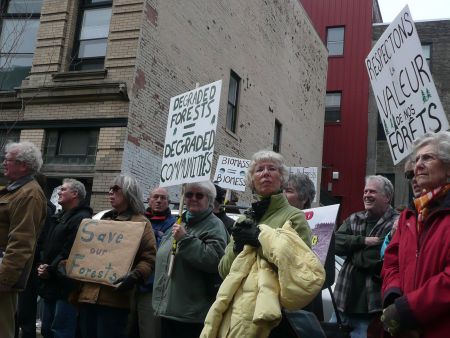“Today we ask for the strength, and the wisdom, to put all our voices together. To make sure that each and every one of us will put our efforts forward to live out the responsibility that's been given to us by the Creator. And to use those gifts, that we have been given, to help those that are in need. And thank the Creator, for giving us such a wonderful day, to voice our concerns for something that is a source of life for everyone.”
With these words Albert Marshall, representative from the Mi'kmaw Elders of Unama'ki (Cape Breton), opened the press conference segment of Wednesday's 'Rally For Our Forests', in Halifax, Nova Scotia.
Representatives of 54 concerned groups from across the province descended upon the conference room of the Four Points Sheraton to show their solidarity in demanding that the Provincial Government make good on the 'Strategic Directions' contained within the now months overdue 'Natural Resources Strategy'. The Strategy, touted by the Province as 'A Policy Framework for the Future of Nova Scotia's Forestry', is a promising document which, if implemented, is a step in the right direction towards sustainably managing the forests. The document was tabled in a multi-phase process that involved extensive public consultation, and it is fair to say that it represents the voice of the Nova Scotian people.
Unfortunately, for the moment it remains but one more promising document on which the Provincial Government has failed to act. The forests are without a policy framework, and with a new 'Renewable Electricity Plan' rolling into place, with its hefty “renewable” energy mandates for the province, there is a literal fire sale on Nova Scotia's remaining forests. By some stretch of the political imagination, whole-tree clear cutting has been earmarked as a suitable means to harvest trees, and from these trees the Province is eager to generate electrical power at approximately 30% energy-capture. This is a bad idea on so many levels it baffles this reporter's mind.
The 54 groups in attendance ran the gamut of forestry professionals, independent woodlot owners, naturalist and nature groups galore, tourism operators, fish and game associations, environmental protection agencies, and young Canadians. All were united in signing the Ecology Action Centre-penned petition to Premier Dexter, which urged the Premier to:
“Act immediately to fulfill (the) government's commitments and responsibility to Nova Scotians to...reform forestry practices...put the brakes on forest biomass electricity projects and...move forward aggressively on (the) province's protected wilderness area goals.”
Albert Marshall, as the designated speaker from the Mi'kmaw Elder of Cape Breton, further addressed the hundred-odd protestors and media in attendance.
“In our culture we have been led to believe that one can and should sustain themselves without compromising, first of all, the ecological integrity of the area. And most importantly...in sustaining ourselves we also have to look into the future. The Seven Generations, for example.”
Marshall continued:
“We are asking you to ask yourself, 'What is the forest? What is the forest for?' From our understanding, forest is, and always was, a source of life. It has provided all our needs. Our dwelling needs. Our food. Our clothing. Our medicines. And our spiritual needs...I do believe that we should, on a daily basis, remind ourselves that our natural world is not an object. It's a subject. And it needs the same kind of affection and consideration like every other living thing. We cannot allow the government, or whoever, to keep extracting...from her.”
Those in attendance then learned of a classic example of “If the science doesn't fit, find other science:" The Provincial government has recently commissioned, to the tune of $100,000 of taxpayer's money, an independent study from an outside, American, firm, to see if the science behind the recommendations contained within the 'Natural Resource Strategy' was indeed sound.
Bob Bancroft, one of the most well-respected naturalists and biologists in the province, and a now-retired 18-year veteran forest biologist with the Department of Resources, chaired the forest panel of expertise for the Natural Resource Strategy. Dismayed at the government's response to the strategy he himself had been instrumental in drafting, on a volunteer basis no less, he spoke of a recent meeting with a crew from National Geographic, here to cover the province's coyote cull.
“It was their first visit to Nova Scotia. These world travellers drove to my home in Pomquet, east of Antigonish...and their first question was 'What's wrong with the forests?' I think that tells a lot. I'm a scientist...but one doesn't have to be a scientist to notice the scrawny forests left over from repeated harvests in Nova Scotia. It's time to rehabilitate those forests...before they deteriorate to scrub or heath.”
Led by a Nova Scotian piper, a placard-laden crowd then marched down Hollis Street to the provincial legislature, meeting several dozen protestors already in attendance. The mood was angry and confrontational, as the entire protest seemed to mirror a 'rally for our forests' that was held in October of 2010. The demands of that protest, the same as today, now months and thousands of clear cut trees ago, apparently fell upon the province's deaf ears. At the October rally, then Provincial Minister of Natural Resources, John MacDonnell, promised “A reduction in clear cutting in Nova Scotia...and no whole tree harvesting in Nova Scotia.”
At Wednesday's rally, as clear cutting continues unabated, and whole trees continue to fill the maws of hungry biomass harvesters, now Provincial Minister of Natural Resources Charlie Parker found himself at times drowned out by the yells of irate and fed-up protestors. Parker asked for patience. The patience of the crowd, and Nova Scotia, was, and is indeed, being tested.



